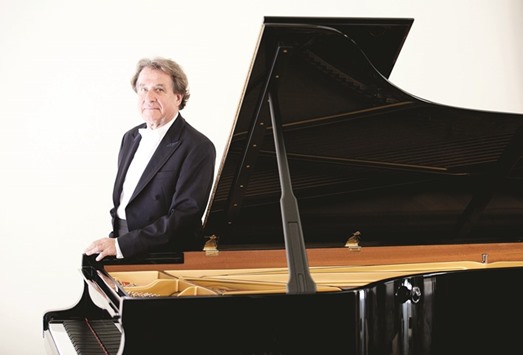
THE PERFORMER: Rudolf Buchbinder is firmly established as one of the world’s foremost pianists.
Legendary Viennese piano maestro Rudolf Buchbinder is bringing to Doha audience the melodies of one of the best German composers of all times Ludwig Van Beethoven. Weaving magic with his fingers, Buchbinder will conduct Beethoven Ludwig van Beethoven: Piano Concerto No. 2 in B Flat Major, Op. 19, Piano Concerto No. 4 in G Major, Op. 58 and Piano Concerto No. 3 in C Minor, Op. 37.
The Qatar Philharmonic Orchestra (QPO) organised concert will take place at Katara Opera House on January 21.
Buchbinder is firmly established as one of the world’s foremost pianists and is frequently invited by major orchestras and festivals around the world. His comprehensive repertoire encompasses numerous 20th century compositions.
His emphasis lies in his meticulous study of musical sources. He owns 35 complete editions of Beethoven’s sonatas and has an extensive collection of autograph scores, first editions and original documents. In addition, Buchbinder possesses copies of the autograph scores and piano parts of both Brahms concertos.
More than 100 recordings document the scope and diversity of Rudolf Buchbinder’s repertoire. Notable recordings to his credit include Haydn’s complete works for piano, which caused a stir and earned him the Grand Prix du Disque, as well as ‘Waltzing Strauss’, a CD featuring piano transcriptions.
Today, Buchbinder favours live recordings, a preference which has resulted in a CD with the Brahms piano concertos (Royal Concertgebouw Orchestra, Nikolaus Harnoncourt) and in two DVDs featuring six Mozart concertos with Buchbinder as pianist and conductor of the Vienna Philharmonic at the 2006 Vienna Festwochen.
Another live recording of the two Brahms piano concertos, released in 2010, was made together with the Israel Philharmonic and Zubin Mehta. In May 2011, Buchbinder’s performances as pianist and conductor in Beethoven’s five piano concertos at Vienna’s Musikverein together with the Vienna Philharmonic were released on DVD and Blu-ray.
In November 2012, Buchbinder presented a live recording of Mozart concertos with Concentus Musicus Wien and Nikolaus Harnoncourt. The interpretation of the ‘new testament’ of the piano repertoire has developed into a core interest for Buchbinder.
He continued to set standards with his performances of the complete 32 sonatas by Ludwig van Beethoven in more than 40 cities, among them Vienna, Munich, Zurich, St. Petersburg, Buenos Aires, Beijing and Milan. In the 2012-13 concert seasons Rudolf Buchbinder performed his entire Beethoven cycle in the chamber music hall of the Philharmonie Berlin.
Throughout the 2010-11 season he maintained a particularly close cooperation with the Staatskapelle Dresden as the orchestra’s first Artist in Residence. His cycle of all Beethoven piano sonatas at the Semperoper in Dresden was recorded live and released in May 2011 as a CD box by Sony-RCA Red Seal. In 2012 it won the prestigious Echo Klassik Award in the category ‘Instrumentalist of the Year.’
Rudolf Buchbinder is the founding artistic director of the Grafenegg Music Festival near Vienna, which has quickly gained its rank among the major orchestra festivals in Europe since its foundation in 2007.
In his biography Da Capo, which includes an introduction by German music critic Joachim Kaiser, Buchbinder offers insights into his life as one of today’s most distinguished pianists.
Beethoven’s Piano Concerto No. 2 in B-flat major, Op. 19 was composed primarily between 1787 and 1789, although it did not attain the form it was published as until 1795. Beethoven did write another finale for it in 1798 for performance in Prague, but that is not the finale that it was published with.
It was used by the composer as a vehicle for his own performances as a young virtuoso, initially intended with the Bonn Hofkapelle. It was published in 1801, by which time he had also published the Piano Concerto No. 1 in C major, although it had been composed after this work, in 1796 and 1797.
The B-flat major Piano Concerto became an important display piece for the young Beethoven as he sought to establish himself after moving from Bonn to Vienna. He was the soloist at its premiere on March 29, 1795, at Vienna’s Burgtheater in a concert marking his public debut. Prior to that, he had performed only in the private salons of the Viennese nobility.
While the work as a whole is very much in the concerto style of Mozart, there is a sense of drama and contrast that would be present in many of Beethoven’s later works.
